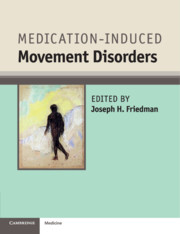Book contents
- Medication-Induced Movement Disorders
- Medication-Induced Movement Disorders
- Copyright page
- Dedication
- Contents
- Contributors
- Introduction: medication-induced movement disorders
- Chapter 1 Acute akathisia
- Chapter 2 Acute dystonia
- Chapter 3 Neuroleptic malignant syndrome
- Chapter 4 Serotonin syndrome
- Chapter 5 Neuroleptic parkinsonism
- Chapter 6 Tardive syndromes
- Chapter 7 Tardive dyskinesia treatment
- Chapter 8 Atypical antipsychotics and movement disorders
- Chapter 9 Restless legs syndrome
- Chapter 10 Medication-induced tremors
- Chapter 11 L-dopa dyskinesias
- Chapter 12 VPA, lithium, amiodarone, and other non-DA
- Chapter 13 Antidepressants and movement disorders
- Chapter 14 Ataxia
- Chapter 15 Myoclonus and asterixis
- Chapter 16 Imaging in medication-induced parkinsonism
- Chapter 17 Deep brain stimulation for tardive disorders
- Index
- References
Chapter 11 - L-dopa dyskinesias
Published online by Cambridge University Press: 05 July 2015
- Medication-Induced Movement Disorders
- Medication-Induced Movement Disorders
- Copyright page
- Dedication
- Contents
- Contributors
- Introduction: medication-induced movement disorders
- Chapter 1 Acute akathisia
- Chapter 2 Acute dystonia
- Chapter 3 Neuroleptic malignant syndrome
- Chapter 4 Serotonin syndrome
- Chapter 5 Neuroleptic parkinsonism
- Chapter 6 Tardive syndromes
- Chapter 7 Tardive dyskinesia treatment
- Chapter 8 Atypical antipsychotics and movement disorders
- Chapter 9 Restless legs syndrome
- Chapter 10 Medication-induced tremors
- Chapter 11 L-dopa dyskinesias
- Chapter 12 VPA, lithium, amiodarone, and other non-DA
- Chapter 13 Antidepressants and movement disorders
- Chapter 14 Ataxia
- Chapter 15 Myoclonus and asterixis
- Chapter 16 Imaging in medication-induced parkinsonism
- Chapter 17 Deep brain stimulation for tardive disorders
- Index
- References
Summary

- Type
- Chapter
- Information
- Medication-Induced Movement Disorders , pp. 110 - 130Publisher: Cambridge University PressPrint publication year: 2015
References
- 1
- Cited by

